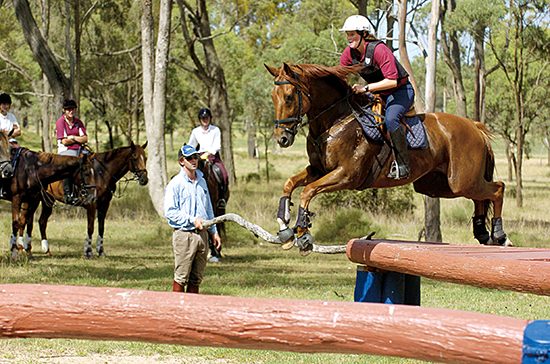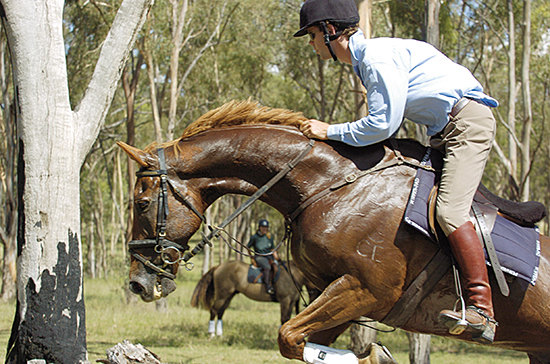 Story by Chris Hector and Photos by Roz Neave
Story by Chris Hector and Photos by Roz Neave
People talk about riders having ‘good hands’ and while we all know that the hands are nothing without the interplay of the leg and seat, the fact remains, there are some riders who seem to have that uncanny attribute – hands that are independent of their body.
Kevin McNab is one of those riders with magic hands, and it is interesting to watch him attempt to teach a group of mere mortals, how to use their hands.
“If you just drop your hand at the last minute, the horse is going to feel you’ve abandoned him. Keep a nice contact, soften, let him stretch over the fence. You’ve got to learn to trust him – get there, soften, and let him produce a shape. If you get too protective and shorten him too much, you don’t let him find his shape. Trust him more, because at the end of the day, he is going to jump because he wants to – you can’t make him,” he tells a group of keen cross-country riders at the Warwick Eventing School.
Part of the problem was with riders trying the ‘short cut’ – severe bits. According to Kevin these bits were not a solution, but more a part of the problem:
“You’ve got to watch out when you put on a bigger bit for extra control – you’ve got to be prepared to let go of it, otherwise you are just riding the bit, and as soon as you hang on, the horse is going to jack up. The horse has to listen to your half halt. You have got to train him so he’ll work in a snaffle.”
This is when we are introduced to the McNab Principle: you can’t know if you’ve got acceleration unless you check the brakes.
“With the group I was teaching at Warwick, I found that three out of the four had strong bits on, because none of them could hold their horse. When I got them to slow down, they found that they had no accelerator, they’d close their leg and nothing would happen. In their approach to the fence, the horse would run in, and they would just hold on and control the bit. When they slowed them down, they had no engine, the motor wasn’t running.”
So what did you have to do?
“Start from scratch. Slow them down, then ride forward at the fence. They should always put themselves in a position where they can ride forward to the fence, rather than come in holding.”
It’s cruel, of course, for the rider who is having problems, when Kevin gets on the horse that has been stacking on a turn, and immediately it flows easily towards the jump and jumps it sweetly. Easy… easy that is when you have wonderful lower leg, totally independent giving hands and superb upper body control. It is not just the ability to give over the jump, but the ability to resume contact smoothly, easily, effectively and softly on the landing side.
“I guess the fear factor is really hard for some people to deal with, and unless they trust you 300%, they still want to hold on. When you can actually get them to slow down it is different, that’s why I did a lot of work out of trot. Slow down, trot into a small fence, and be confident enough to let go – so they actually get a feel that that will work. Do that, and they are more likely to try and ride it like that when the fences get a bit bigger.”
You have a very fancy release system happening over a fence – where did you develop that technique?
“I was lucky to start out with Tony Manca who really drilled me on that, from the beginning I learnt that was the way to ride, so it was probably a lot easier for me, than for the kids who did it on their own and got into bad habits – it’s harder to fix the second time around. Tony was really very fussy about that.”
And the other side, if you are fussy about your hands and release, then you have to be fussy about the lower leg that gives you the security to be able to do that?
“Yeah, you have to have a secure position so you feel free to do that. A lot of people, specially some of the kids you teach, are still relying on their reins for balance.”
How did you get to work with Tony?
“I was doing year 11 and 12 at Kooralbyn School, and I think my mum met him and organized for me to have a lesson with him, and we went from there. I actually spent two years with Tony and Tracey Manca, and I still get a hand from both of them.”
“I grew up in far north Queensland, and went through the pony club. When I finished year 10, I decided I wanted to move south so I could do more eventing. Kooralbyn was the only school that had an equestrian course – Judy Howard, who rode at the World Eventing Championships in Gawler in 1986 was in charge of the program. After Kooralbyn I spent time with Tony, then moved down to the Hunter Valley in NSW.”
You have always tried to be a stylish sort of rider?
“I try… I’ve been taught the less you do to interfere with the horse, the better the chance he has to produce a jump.”
So where did you get the eventing bug?
“There wasn’t any eventing where I grew up, it was just always something I wanted to do. I grew up reading The Horse Magazine and saw all the eventing articles, and that’s what I wanted to do.”
You worked at the NSW Equestrian Centre with Heath and Rozzie Ryan?
“I went there to do my level 1. Once I got down there, I got the bug and stayed there.”
Was that a shock to the system – Heath yelling at you?
“It wasn’t a shock to the system, I fitted right in. It was a lot of fun. It was amazing then, there were a lot of friends living at Branxton, just near the Centre, and we all worked and rode together. It’s amazing how quickly you can learn when you all work together.”
So what happened that you ended up in Germany working with Wolfram Wittig?
“Boyd Martin’s girlfriend, Sylva Stigler had worked with Wolfram and she got me in there. Wolfram was amazing with his horses, he really loves his horses and the horsemanship there was amazing. They were all happy horses, and happy horses are normally sound horses.”
So what did you bring back to Australia from Germany?
“Running a tidier show, being more particular, more attention to detail.”
Do you have more travel plans?
“I certainly do. I’d like to go back to Germany and spend some time in a showjumping stable. I’d like to go to America and do some time there, and I would also like to spend a couple of seasons in England. That should keep me busy.”
You have always been interested in the breeding side of the horse scene, is that becoming more and more a part of being an eventer?
“I think a lot of the eventers are going into breeding a few of their own, or at least buying them off the breeders, rather than just ex-racehorses. That’s the trend and I see it getting stronger. I’d like to have a couple more mares myself. I’m not in that position at the moment, but in the future I will definitely be trying to breed my own horses as much as I can.”
How much Warmblood do you think they will be able to take in the new formats?
“I think it really depends on the horse. It’s not a matter of a quarter or a half, something that can gallop still – so we mean a lighter type, but some quarter Warmbloods can still be very heavy. It depends on the individual horse.”
How important is the flash trot going to be in the future?
“At the end of the day you have to be on a jumper. But if you are not in the race after the dressage, you are not in the race. If they can really jump I’ll still start them but the ones I will chase are the ones that can jump and move. I’ll still pick a jumper over a dressage horse.”
You enjoy teaching the kids at the Warwick School?
“I get a real buzz, especially the young kids because they come on quickly. It so much fun because they progress so quickly. The guys that are more established, if you can help them a little bit, you’ve done a good job.”
Do you teach much?
“I’ve actually been doing a lot more teaching in the last couple of years since I’ve been back in Queensland. I guess you can only ride so many horses, and the horses I do ride, I’d like to do really well and not ride too many. I teach a bit of everything. The galloping housewives are great fun because it is low stress, they want to ride and have fun – but it is also good teaching the talented ones that are coming on, that is when you can see something happening.”
There’s a whole group of super talented younger eventing riders out there right now, all looking for that next super horse, and when they find them, watch out world… and my betting is that Kevin McNab is going to find his special horse before too long, and the boy from far North Queensland will make his run…

